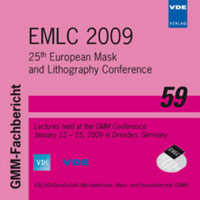MeRiT(R) repair verification using in-die phase metrology Phame(R)
Konferenz: EMLC 2009 - 25th European Mask and Lithography Conference
12.01.2009 - 15.01.2009 in Dresden, Germany
Tagungsband: EMLC 2009
Seiten: 7Sprache: EnglischTyp: PDF
Persönliche VDE-Mitglieder erhalten auf diesen Artikel 10% Rabatt
Autoren:
Buttgereit, Ute; Birkner, Robert; Stelzner, Robert (Carl Zeiss SMS GmbH, Carl Zeiss Promenade 10, 07745 Jena, Germany)
Inhalt:
With the transition of lithography into 45nm node and beyond the industry faces the challenge that mask complexity increases steadily, mask specifications tighten and process control becomes extremely important. The use of Phase Shifting Masks (PSM), combined with off-axis illumination schemes, is essential to print feature sizes going beyond the lithographic wavelength. In conjunction with the shrinking feature size the tolerable defect size shrinks as well. This goes along with rising mask costs and therefore a high first pass yield becomes more important than ever. Repair strategies are required which have the potential to support the trend of decreasing tolerable defect sizes for both clear and opaque defects. In case of PSM it is not only important to remove material, of special interest is the capability to repair phase defects. This requires material deposition and etching accounting for transmission and phase as well. The ebeam repair system MeRiT(R) MG 45 is based on the GEMINI(R) column and allows etching and deposition to repair both clear and opaque defects with high resolution and edge placement precision. In this paper we focus on repair of phase defects on 6% att. PSM. We concentrate on 45nm lines/spaces looking into different defect dimensions. At feature sizes of 45nm CD, corresponding to 180nm CD at mask, feature topography already impacts the phase shift. Therefore a base line investigation is performed evaluating the correlation between deposited PSM layer height and phase shift covering also the impact of 3D mask effects on phase shift. The deposited layer height is measured using AFM. For phase evaluation the newly developed phase metrology system Phame(R) was used. Phame(R) enables optical phase shift measurement with high spatial resolution down to 120nm half pitch on mask. On-axis and off-axis illumination can be applied according to the required scanner settings during wafer printing. Phame(R) captures imaging effects as well as 3D mask effects which are of special importance for further shrinking feature sizes.


